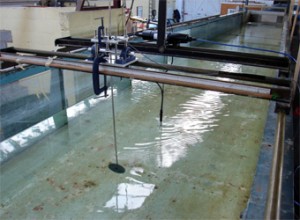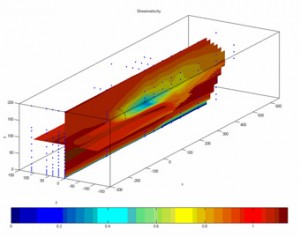Marine current energy conversion technology is presently at the prototype stage where single devices are deployed, or planned for installation, at isolated testing sites. In the medium term, however, devices will be installed in arrays. Understanding the effect devices have on the flow is critical in determining how one device may modify both the performance of and loading experienced by another device in the array. It is the aim of this work to identify and investigate the parameters which govern the wake structure and its recovery to the free-stream velocity profile. Scale model testing is being conducted to aid the development of an efficient numerical model.
As a marine current turbine extracts energy from the tidal current a wake forms downstream of the rotor. This takes the form of a gradually expanding cone of fluid that has a velocity less than the fluid that passes around the rotor. As the wake travels downstream its mean velocity increases as it mixes with free stream fluid. The velocity deficit it essentially the decimal percentage of the upstream speed so a velocity deficit equal to zero equates to the flow speed being equal to that upstream of the rotor (0.2 is 80% upstream speed etc.). It is clear that the wake can recover at different rates and that it can take a long distance downstream to recover to 90% of the upstream speed.
This work is being conducted by SERG along with Garrad Hassan who is responsible for developing a 3-D numerical model that will be validated by experimental data from SERG. Further partners are Lunar Energy and SMD Hydrovision. The figures shows a visualisation of the wake flow downstream of a mesh disk rotor simulator tested at the 21m Civil Engineering flume at the Chilworth Hydraulics Laboratory. The blue dots represent points where mean velocity and turbulence intensity was measured. The blue colours immediately downstream of the disk show that the fluid is immediately slowed quite dramatically. As the wake continues downstream the velocity starts to increase and the wake expands as described earlier.
This work is funded by the Department for Innovation, Universities & Skills(formerly DTI – Department of Trade & Industry) and will end in 2008 shortly before the first marine energy converter arrays are due to be installed.

